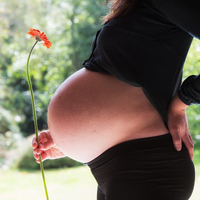Prevention of congenital malformations for pregnant women: A predictive model based on a study in eastern Algeria’s population

Accepted: July 4, 2021
Questionnaire: 0
All claims expressed in this article are solely those of the authors and do not necessarily represent those of their affiliated organizations, or those of the publisher, the editors and the reviewers. Any product that may be evaluated in this article or claim that may be made by its manufacturer is not guaranteed or endorsed by the publisher.
The World Health Organization (WHO) defines congenital malformation as any gross abnormality present at birth even if it is not immediately recognized. Here, we aimed to identify the factors predisposing to congenital malformations in pregnant women in Eastern Algeria and the effect of the combination of several factors. 786 pregnant women were interviewed. Throughout our study, we sought to find answers, discuss the association between malformation exposure, identify the risk factors, and predict the occurrence of malformations using statistical analysis techniques. We developed a predictive model and we found that malformations were significantly higher for pregnant women aged over 34 (10.93; 95% CI: 2.10- 201.71, p=0.023), with a BMI over 25 (2.38; 0.91-7.04, p=0.091), hypertension (2.18; 1.04-4.57, p=0.038), anemia (2.08; 0.98-4.35, p=0.053) and infections (2.32; 1.18-4.58; p=0.015). Protecting factors against malformations includes diet moderate in meat (1.97; 0.73-4.98, p=0.163) and rich in eggs, soft drinks, and fruit-vegetables (2.69; 0.76-8.63, p=0.106), (1.84; 0.74-4.43, p=0.177), (3.08; 0.56-13.28, p=0.154); respectively. Knowing risk factors helps to establish predictive models and strategies to prevent malformations and highlights the link between malformations and multiple risk factors for the sake of protecting babies’ lives.
Delabaere A, Huchon C, Deffieux X, et al. Épidémiologie des pertes de grossesse. J Gynecol Obstet Biol la Reprod 2014;43:764–75. DOI: https://doi.org/10.1016/j.jgyn.2014.09.011
McClure JH, Cooper GM, Clutton-Brock TH. Saving mothers’ lives: Reviewing maternal deaths to make motherhood safer: 20068: A review. Br J Anaesth 2011;107:127–32. DOI: https://doi.org/10.1093/bja/aer192
Dong DY, Binongo JN, Kancherla V. Maternal chlamydia infection during pregnancy and risk of cyanotic congenital heart defects in the offspring. Matern Child Health J 2016;20:66–76. DOI: https://doi.org/10.1007/s10995-015-1804-0
Boyd PA, Armstrong B, Dolk H, et al. Congenital anomaly surveillance in England—ascertainment deficiencies in the national system. BMJ 2005;330:27. DOI: https://doi.org/10.1136/bmj.38300.665301.3A
Given JE, Loane M, Garne E, et al. Metformin exposure in first trimester of pregnancy and risk of all or specific congenital anomalies: Exploratory case-control study. BMJ 2018;361:18–20. DOI: https://doi.org/10.1136/bmj.k2477
El Sanharawi M, Naudet F. Comprendre la régression logistique. J Fr Ophtalmol 2013;36:710–5. DOI: https://doi.org/10.1016/j.jfo.2013.05.008
AFRO. Stratégie de Coopération de l’OMS avec l’Algérie, 2016-2020. OMS/AFRO. Brazzaville, Congo, WHO; 2016. Available from: https://www.afro.who.int/sites/default/files/2017-06/ccs---algérie-16-20.pdf
Bouklia H. Progression de la mise en œuvre des ODD [Internet]. Algeria; 2019. Avaialble from: http://ambalgott.com/actualite/ODD.php
Haoud K, Mellali S, Gouas L, et al. Prevalence of aneuploidies in products of spontaneous abortion: Interest of FISH and MLPA. Morphologie 2014;98:40–6. DOI: https://doi.org/10.1016/j.morpho.2014.02.001
Mellali S, Haoud K, Gouas L, et al. Prenatal BoBsTM in the cytogenetic analysis of products of spontaneous miscarriage. South African Med J 2015;105:870–3. DOI: https://doi.org/10.7196/SAMJnew.8121
Fuchs F, Monet B, Ducruet T, et al. Effect of maternal age on the risk of preterm birth: A large cohort study. Obstet Gynecol Surv 2018;73:340–2. DOI: https://doi.org/10.1097/01.ogx.0000541308.53092.4a
Johansson S, Villamor E, Altman M, et al. Maternal overweight and obesity in early pregnancy and risk of infant mortality: A Population based cohort study in Sweden. BMJ 2014;349:1–12. DOI: https://doi.org/10.1136/bmj.g6572
Reynolds RM, Allan KM, Raja EA, et al. Maternal obesity during pregnancy and premature mortality from cardiovascular event in adult offspring: Follow-up of 1 323 275 person years. BMJ 2013;347:1–10. DOI: https://doi.org/10.1136/bmj.f4539
Ju AC, Heyman MB, Garber AK, Wojcicki JM. Maternal obesity and risk of preterm birth and low birthweight in Hawaii PRAMS, 2000–2011. Matern Child Health J 2018;22:893–902. DOI: https://doi.org/10.1007/s10995-018-2464-7
Heude B, Thiébaugeorges O, Goua V, et al. Pre-pregnancy body mass index and weight gain during pregnancy: Relations with gestational diabetes and hypertension, and birth outcomes. Matern Child Health J 2012;16:355–63. DOI: https://doi.org/10.1007/s10995-011-0741-9
Pan ML, Chen LR, Tsao HM, Chen KH. Prepregnancy endocrine, autoimmune disorders and the risks of gestational hypertension-preeclampsia in primiparas: A nationwide population-based study in Taiwan. Int J Environ Res Public Health 2020;17. DOI: https://doi.org/10.3390/ijerph17103657
Behrens I, Basit S, Lykke JA, et al. Association between hypertensive disorders of pregnancy and later risk of cardiomyopathy. JAMA 2016;315:1026–33. DOI: https://doi.org/10.1001/jama.2016.1869
Nelson DB, Hanlon AL, Wu G, et al. First trimester levels of BV-associated bacteria and risk of miscarriage among women early in pregnancy. Matern Child Health J 2015;19:2682–7. DOI: https://doi.org/10.1007/s10995-015-1790-2
Culhane JF, Rauh V, McCollum KF, et al. Maternal stress is associated with bacterial vaginosis in human pregnancy. Matern Child Health J 2001;5:127–34. DOI: https://doi.org/10.1023/A:1011305300690
Nelson DB, Bellamy S, Nachamkin I, et al. Characteristics and pregnancy outcomes of pregnant women asymptomatic for bacterial vaginosis. Matern Child Health J 2008;12:216–22. DOI: https://doi.org/10.1007/s10995-007-0239-7
Gernand AD, Schulze KJ, Stewart CP, et al. Micronutrient deficiencies in pregnancy worldwide: Health effects and prevention. Nat Rev Endocrinol 2016;12:274–89. DOI: https://doi.org/10.1038/nrendo.2016.37
Scott JM. Evidence of folic acid and folate in the prevention of neural tube defects. Forum Nutr 2001;55:192–5. DOI: https://doi.org/10.1159/000059465
PAGEPress has chosen to apply the Creative Commons Attribution NonCommercial 4.0 International License (CC BY-NC 4.0) to all manuscripts to be published.


 https://doi.org/10.4081/jbr.2021.9394
https://doi.org/10.4081/jbr.2021.9394



